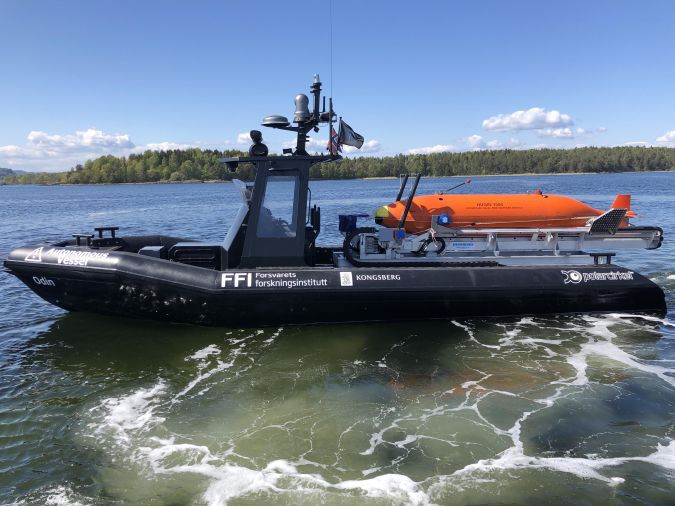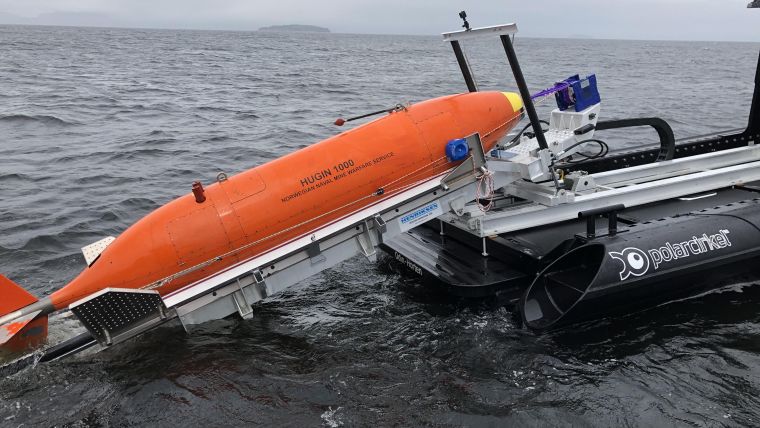This Is How an Unmanned Launch and Recovery System Operates
The smooth launch and recovery of a Hugin autonomous underwater vehicle (AUV) has been demonstrated using a new system from H. Henriksen AS. Capable of being used by a wide range of small manned or unmanned auxiliary craft, the Henriksen Launch and Recovery System introduces a versatile new option for the operators of AUVs and UUVs. The lightweight Henriksen launch system can be deployed by any craft capable of supporting its weight and that of the AUV. The Hugin AUV used to test the system was 5.5 metres long and weighed 780 kg, yet with the Henriksen launch system it was well within the capabilities of the RIB (Rigid Inflatable Boat) chosen to carry it.
The initial test was performed with a modified launch and recovery system designed for bigger ships. H. Henriksen is now designing the first generation system dedicated for use on smaller boats such as an unmanned surface vehicle (USV). The new system will optimize weight, have a lower centre of gravity and reduce hydrodynamic drag when extended into the water. By using the smallest boat capable of carrying the AUV and its launch system, the user benefits from lower operating costs combined with the increased manoeuvrability that smaller boats provide.
A Radio or AUV Controlled Hook
The key feature of the Henriksen Unmanned Launch and Recovery system is its use of a radio or AUV controlled hook that is fitted into the nose of whatever vehicle is being deployed. Manufactured by Henriksen, a manufacturer of boat lifting hooks, its strength and reliability are therefore guaranteed. The Henriksen Launch System can be adapted to fit whichever boat the operator decides to use and can be employed to pick up or launch any AUV that has been equipped with the remotely operated nose hook.

Launch operations see the new system’s stinger extended over the stern of the boat with the AUV carried on its bed. The stinger is then tilted to position its end just under the water. The operator then uses a radio signal to open the AUV’s nose hook, which releases the retaining line and enables the AUV to slide down the stinger into the water and start work.
Active Sea Conditions
Recovery of the AUV is possible in active sea conditions regardless of whether it is under power or not. The deployment boat will capture the AUV with its stinger extended into the water. The boat is manoeuvred so that the nose of the AUV moves onto the stinger bed, where the hook on its nose automatically captures a self-tensioned winch line. This is used to pull the AUV out of the water and up onto the stinger bed. The stinger is then raised and retracted bringing the AUV inboard where it is made fast and transported to the mother ship. When the launch boat is alongside, the ship’s davit is then used in conjunction with a fitted Henriksen dual point lifting hook so that it can be hoisted back onto the ship along with its launch and recovery system and the AUV.
Norwegian Defence Research Establishment
The new Unmanned Underwater Vehicle Launch and Recovery System was designed and built by the Maritime Unmanned Systems Division at the Henriksen factory in Tønsberg, Norway. The system has been developed and tested in close cooperation with Norwegian Defence Research Establishment (FFI).
A range of oil spill recovery systems are also built in the same workshops and supplied to coastal authorities and oil companies. The Henriksen REBS division, based at the same location, uses advanced composite materials to manufacture a range of rapid entry boarding systems used by security forces around the world. Henriksen is, however, best known globally as a specialist in the manufacture of high-grade lifting and towing hooks for the maritime industry. It has accumulated many years of expertise in the design of hooks used in safety-critical situations and enjoys a 100% safety record.
For more information visit www.hhenriksen.com.

Value staying current with hydrography?
Stay on the map with our expertly curated newsletters.
We provide educational insights, industry updates, and inspiring stories from the world of hydrography to help you learn, grow, and navigate your field with confidence. Don't miss out - subscribe today and ensure you're always informed, educated, and inspired by the latest in hydrographic technology and research.
Choose your newsletter(s)
























